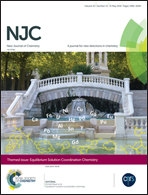CdII/ZnII discrimination using 2,5-diphenyl[1,3,4]oxadiazole based fluorescent chemosensors†
Abstract
The coordination properties and photochemical response of two fluorescent ligands 2,5-bis{2-[bis(2-pyridylmethyl)aminomethyl]phenyl}[1,3,4]oxadiazole (L1) and 2,5-bis{2-[(1,4,7-triazacyclononane-1-yl)methyl]phenyl}[1,3,4]oxadiazole (L2) towards ZnII and CdII are reported. The ligands contain the 2,5-diphenyl[1,3,4]oxadiazole (PPD) fluorescent probe linked to two coordinating units, namely dipicolylamine (DPA) for L1 and 1,4,7-triazacyclononane (TACN) for L2, through a methylene spacer. Both ligands form mononuclear and dinuclear complexes with these metal ions in aqueous or hydro-alcoholic media. With regard to L1, only the mononuclear CdII complex is highly fluorescent at 368 nm, while the mononuclear ZnII and dinuclear CdII and ZnII complexes are not emissive. Ligand L2 forms an excimer emitting at 474 nm only in the presence of one equivalent of CdII, and potentiometric, spectrophotometric, spectrofluorimetric, and NMR studies and DFT calculations were performed to explain this peculiarity. The discrimination between CdII and ZnII is mainly due to the different coordination environments of the metal ions in the mononuclear complexes; namely CdII is coordinated by both the side arms of each ligand, while ZnII is bound only to one coordinating unit.
![Graphical abstract: CdII/ZnII discrimination using 2,5-diphenyl[1,3,4]oxadiazole based fluorescent chemosensors](/lv/Image/Get?imageInfo.ImageType=GA&imageInfo.ImageIdentifier.ManuscriptID=C8NJ00113H&imageInfo.ImageIdentifier.Year=2018)
- This article is part of the themed collection: Equilibrium Solution Coordination Chemistry


 Please wait while we load your content...
Please wait while we load your content...